Lizzie Chimiugak has lived for 90 years in the windswept western wilds of Alaska, born to a nomadic family who lived in mud homes and followed where the good hunting and fishing led.
Her home now is an outpost on the Bering Sea, Toksook Bay, and she is about to become the most well-known woman in the tiny town, where at 90 she is considered an elder: She will be the first person counted in the U.S. Census, taken every 10 years to apportion representation in Congress and federal money.
"Elders that were before me, if they didn’t die too early, I wouldn’t have been the first person counted," Lizzie Chimiugak said, speaking Yup'ik language of Yugtun, with family members serving as interpreters. "Right now, they’re considering me as an elder, and they’re asking me questions I’m trying my best to give answers to, or to talk about what it means to be an elder."
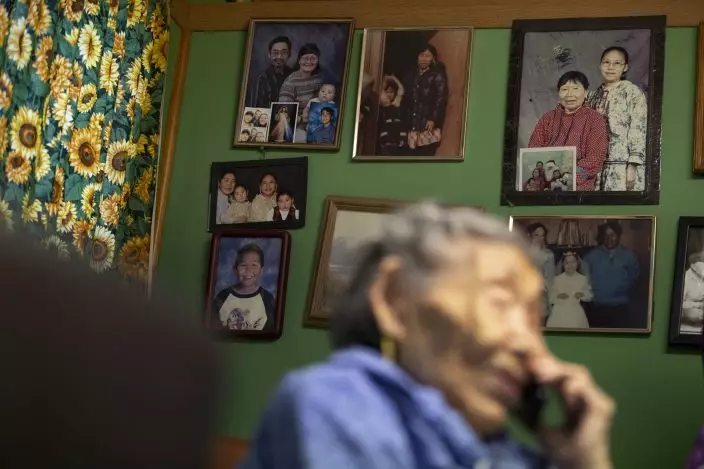
In this Monday, Jan. 20, 2020 image, family pictures hang on the wall as Lizzie Chimiugak talks on the phone at her home in Toksook Bay, Alaska. Chimiugak, who turned 90 years old on Monday, is scheduled to be the first person counted in the 2020 U.S. Census on Tuesday. (AP PhotoGregory Bull)
The decennial U.S. census has started in rural Alaska, out of tradition and necessity, ever since the U.S. purchased the territory from Russia in 1867. The ground is still frozen, which allows easier access before the spring melt makes many areas inaccessible to travel and residents scatter to subsistence hunting and fishing grounds. The mail service is spotty in rural Alaska and the internet connectivity unreliable, which makes door-to-door surveying important.
The rest of the nation, including more urban areas of Alaska, begin the census in mid-March.
On Tuesday, Steven Dillingham, director of the census bureau, will conduct the first interview. Because of federal privacy laws, the bureau won’t even confirm Chimiugak will be the first person counted, even though it’s the worst kept secret in her hometown.
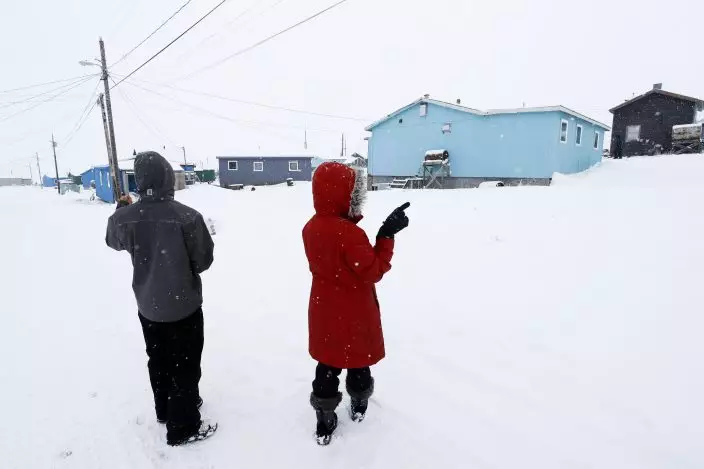
In this Monday, Jan. 20, 2020 photo, census workers verify that their maps match up to the right amount of houses in Toksook Bay, Alaska, a mostly Yup'ik village on the edge of the Bering Sea. Census workers traditionally begin the official decennial count in rural Alaska when the ground is still frozen. That allows easier access before the spring melt makes many areas inaccessible to travel and residents scatter to subsistence hunting and fishing grounds. The rest of the nation, including more urban areas of Alaska, begin the census in mid-March. (AP PhotoGregory Bull)
After the count, a celebration is planned at Nelson Island School, and will include local Alaska Native dancers and traditional food, which could include seal, walrus, musk ox and moose.
Robert Pitka, tribal administrator for Nunakauyak Traditional Council, hopes the takeaway message for the rest of the nation is of Yup’ik pride.
“We are Yup'ik people and that the world will see that we are very strong in our culture and our traditions and that our Yup'ik language is very strong.”
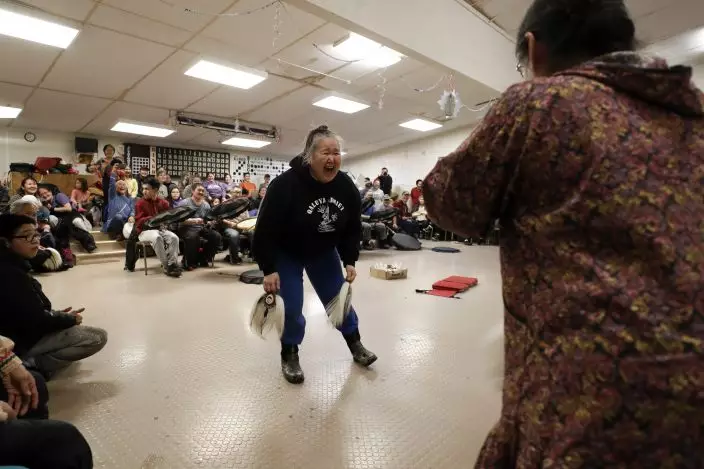
In this Monday, Jan. 20, 2020 photo, Darlene Lincoln, center, laughs as she takes part in an Alaska Native dance in Toksook Bay, Alaska, a mostly Yup'ik village on the edge of the Bering Sea. Census workers traditionally begin the official decennial count in rural Alaska when the ground is still frozen. That allows easier access before the spring melt makes many areas inaccessible to travel and residents scatter to subsistence hunting and fishing grounds. The rest of the nation, including more urban areas of Alaska, begin the census in mid-March. (AP PhotoGregory Bull)
For Chimiugak, she has concerns about climate change and what it might do to future generations of subsistence hunters and fishers in the community, and what it will do to the fish and animals. She plans to talk about it with others at the celebration.
“She’s sad about the future,” he eldest son Paul said.
Chimiugak was born just after the start of the Great Depression in the middle of nowhere in western Alaska, her daughter Katie Schwartz of Springfield, Missouri, said. Lizzie was one of 10 siblings born to her parents, who lived a nomadic lifestyle and traveled with two or three other families that would migrate together, her son said.
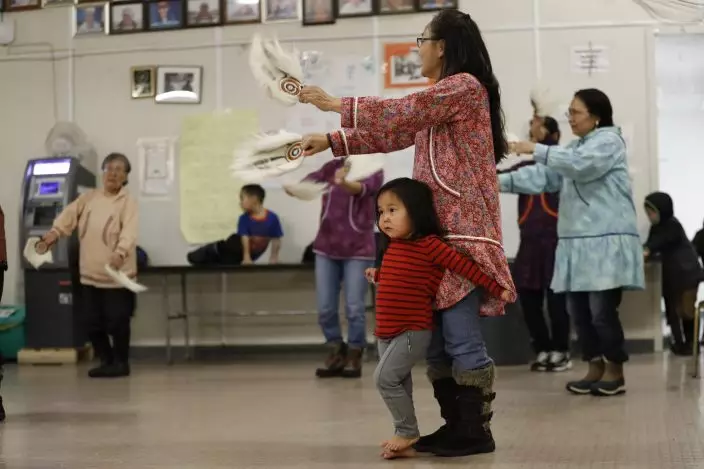
In this Monday, Jan. 20, 2020 photo, Liana Nicholai clings to her grandmother, Dora Nicholai, during an Alaska Native dance in Toksook Bay, Alaska, a mostly Yup'ik village on the edge of the Bering Sea. Census workers traditionally begin the official decennial count in rural Alaska when the ground is still frozen. That allows easier access before the spring melt makes many areas inaccessible to travel and residents scatter to subsistence hunting and fishing grounds. The rest of the nation, including more urban areas of Alaska, begin the census in mid-March. (AP PhotoGregory Bull)
Lizzie and her 101-year-old sister from Nightmute, Alaska, survive.
In 1947 Lizzie married George Chimiugak, and they eventually settled in Toksook Bay after the town was founded in 1964 by residents of nearby Nightmute. There are five surviving children.
He worked maintenance at the airport and she did janitorial work at the old medical clinic and babysat.
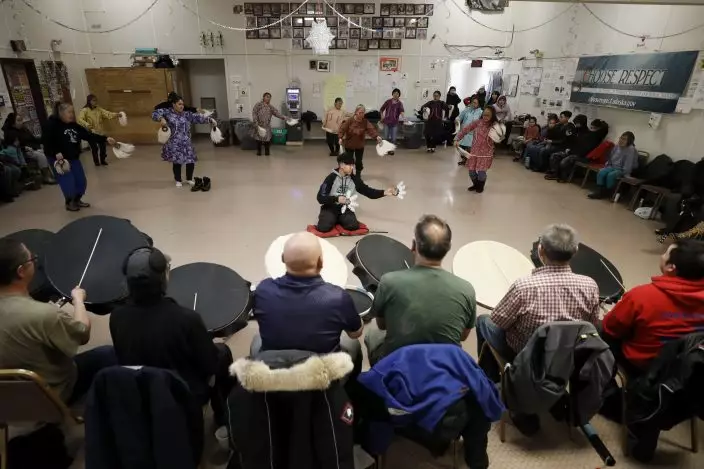
In this Monday, Jan. 20, 2020 photo, people take part in an Alaska Native dance in Toksook Bay, Alaska, a mostly Yup'ik village on the edge of the Bering Sea. Census workers traditionally begin the official decennial count in rural Alaska when the ground is still frozen. That allows easier access before the spring melt makes many areas inaccessible to travel and residents scatter to subsistence hunting and fishing grounds. The rest of the nation, including more urban areas of Alaska, begin the census in mid-March. (AP PhotoGregory Bull)
Like other wives, she cleaned fish, tanned hides and even rendered seal oil after her husband came home from fishing or hunting. Her husband died about 30 years ago.
She is also a woman of strong Catholic faith, and told her son that she saved his life by praying over him after he contracted polio.
For her own hobbies, she weaved baskets from grass and remains a member of the Alaska Native dance group that will perform Tuesday, she dancing in her wheelchair.
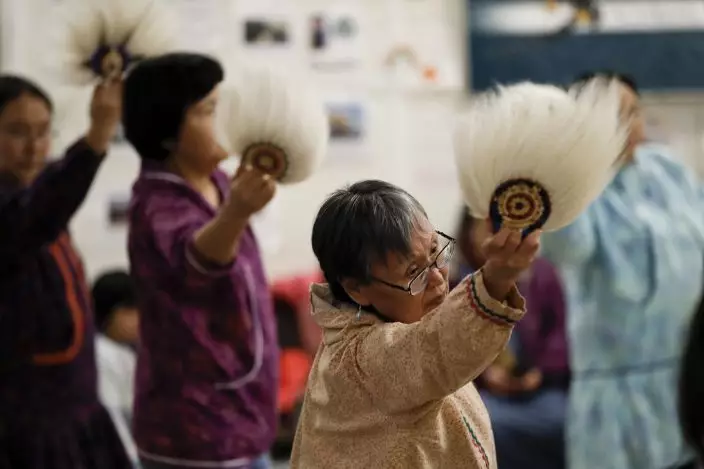
In this Jan. 20, 2020 photo, Mary Acosta, center, takes part in an Alaska Native dance in Toksook Bay, Alaska, a mostly Yup'ik village on the edge of the Bering Sea. Census workers traditionally begin the official decennial count in rural Alaska when the ground is still frozen. That allows easier access before the spring melt makes many areas inaccessible to travel and residents scatter to subsistence hunting and fishing grounds. The rest of the nation, including more urban areas of Alaska, begin the census in mid-March. (AP PhotoGregory Bull)
She taught children manners and responsibility and continued the oral tradition of telling them stories with a storyknife.
Chimiugak used a knife in the mud to illustrate her stories to school children. She drew figures for people or homes. At the end of the story, she'd use the knife to wipe away the pictures and start the next story with a clean slate of mud.
“She's a great teacher, you know giving reminders us of how we're supposed to be, taking care of subsistence and taking care of our family and respecting our parents,” her granddaughter Alice Tulik said. “That's how she would give us advice."
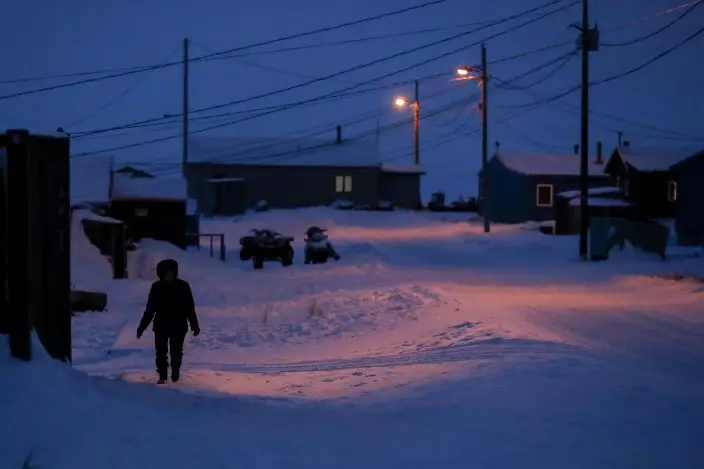
In this Jan. 20, 2020 photo, a woman walks before dawn in Toksook Bay, Alaska, a mostly Yuip'ik village on the edge of the Bering Sea. Census workers traditionally begin the official decennial count in rural Alaska when the ground is still frozen. That allows easier access before the spring melt makes many areas inaccessible to travel and residents scatter to subsistence hunting and fishing grounds. The rest of the nation, including more urban areas of Alaska, begin the census in mid-March. (AP PhotoGregory Bull)
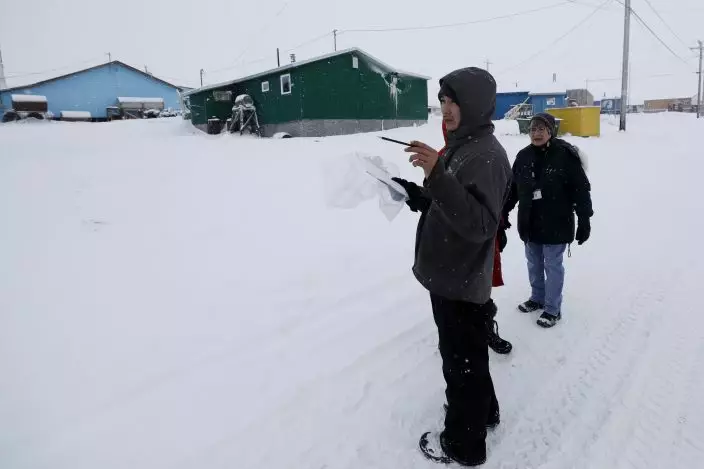
In this Monday, Jan. 20, 2020 photo, census workers verify that their maps match up to the right amount of houses in Toksook Bay, Alaska, a mostly Yup'ik village on the edge of the Bering Sea. Census workers traditionally begin the official decennial count in rural Alaska when the ground is still frozen. That allows easier access before the spring melt makes many areas inaccessible to travel and residents scatter to subsistence hunting and fishing grounds. The rest of the nation, including more urban areas of Alaska, begin the census in mid-March. (AP PhotoGregory Bull)
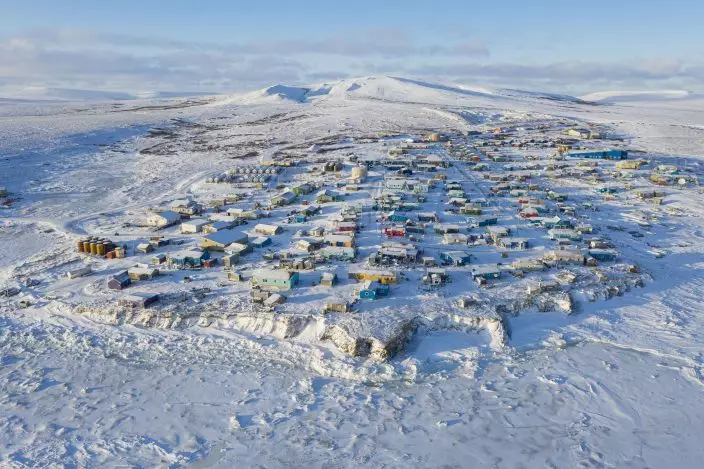
This December 2019 photo shows Toksook Bay, Alaska. The 2020 census in the U.S. begins Tuesday, Jan. 21, 2020, in this tiny community in Alaska. It has started in rural Alaska ever since the U.S. purchased the territory from Russia in 1867. This year, the first people will be counted in Toksook Bay, a city of 661 on the Bering Sea. (Matt HageAP Images for U.S. Census Bureau)
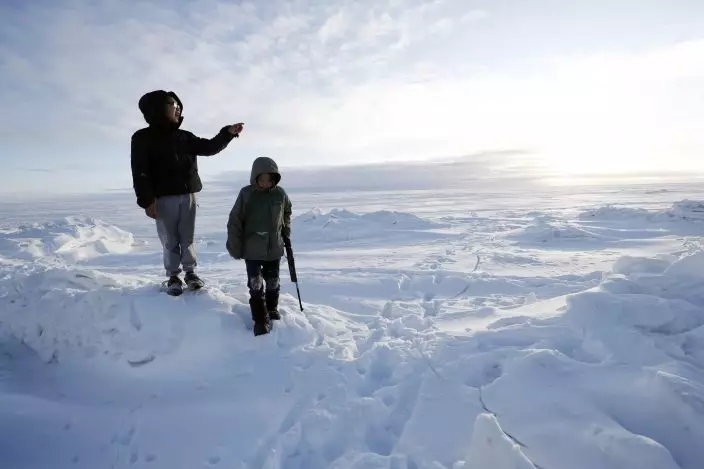
In this Saturday, Jan. 18, 2020, photo, George Chakuchin, left, and Mick Chakuchin look out over the Bering Sea near Toksook Bay, Alaska. The first Americans to be counted in the 2020 Census starting Tuesday, Jan. 21, live in this Bering Sea coastal village. The Census traditionally begins earlier in Alaska than the rest of the nation because frozen ground allows easier access for Census workers, and rural Alaska will scatter with the spring thaw to traditional hunting and fishing grounds. (AP PhotoGregory Bull)
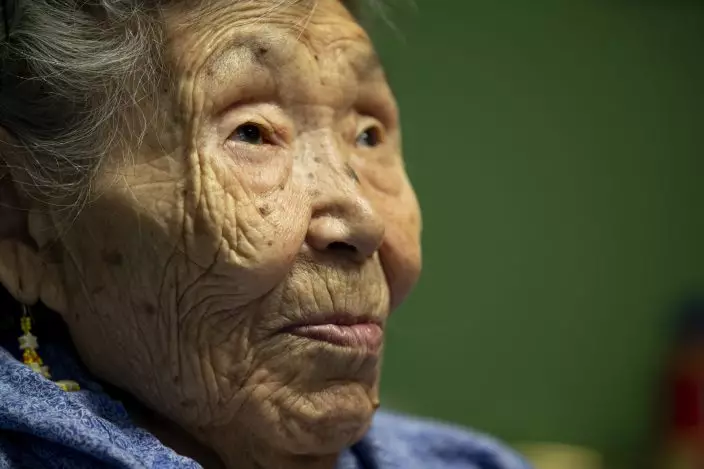
In this Monday, Jan. 20, 2020 image, Lizzie Chimiugak looks on at her home in Toksook Bay, Alaska. Chimiugak, who turned 90 years old on Monday, is scheduled to be the first person counted in the 2020 U.S. Census on Tuesday. (AP PhotoGregory Bull)
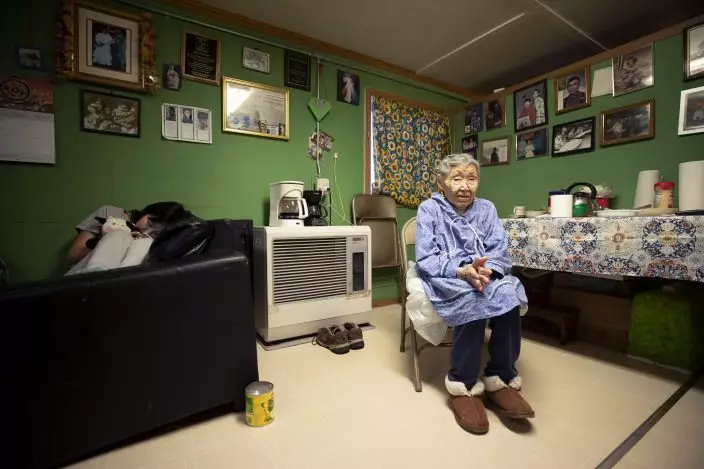
In this Monday, Jan. 20, 2020 image, Lizzie Chimiugak, right, looks on at her home in Toksook Bay, Alaska. Chimiugak, who turned 90 years old on Monday, is scheduled to be the first person counted in the 2020 U.S. Census on Tuesday. (AP PhotoGregory Bull)
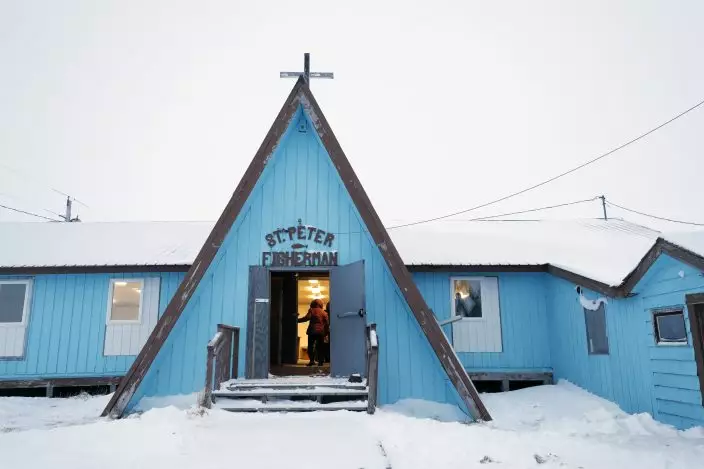
A woman arrives for services at the St. Peter Fisherman Church, Sunday, Jan. 19, 2020, in Toksook Bay, Alaska. The first Americans to be counted in the 2020 Census starting Tuesday, Jan. 21, live in this Bering Sea coastal village. (AP PhotoGregory Bull)

Children play in the snow Saturday, Jan. 18, 2020, in Toksook Bay, Alaska. The first Americans to be counted in the 2020 Census starting Tuesday, Jan. 21, live in this Bering Sea coastal village. The Census traditionally begins earlier in Alaska than the rest of the nation because frozen ground allows easier access for Census workers, and rural Alaska will scatter with the spring thaw to traditional hunting and fishing grounds. (AP PhotoGregory Bull)


